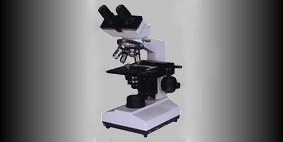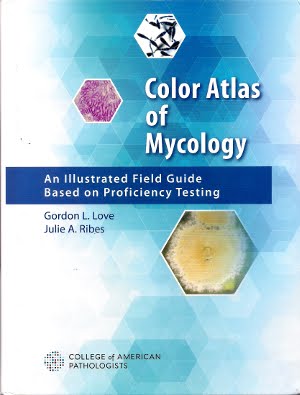Thursday, 3 July 2014
Scopulariopsis brumptii
Scopulariopsis brumptii (Mould/Fungus)
Ecology: A cosmopolitan fungus (found just about everywhere),
particularly in soil and in household dust.
Pathogenicity: Scopulariopsis
brumptii is rarely implicated in
disease; however, as with many other ‘non-pathogenic’ fungi, they may be
considered opportunists and may be increasingly found as the cause of pulmonary
(lung) infections in severely immunocompromised patients. Encountered in the laboratory as a possible
contaminant, they must be distinguished from more pathogenic fungi.
Macroscopic Morphology: S.brumptii is a moderately rapid grower, usually maturing within
about 5 days. Surface growth may
initially be whitish, then darkening from a light grey to a sepia-grey (reddish
overtones) or fuscous (darker brown-grey).
One source described the colour as that of cigarette ash. The grey overtones distinguish it from the cinnamon,
tan or buff brown colour of Scopulariopsis
brevicaulis. The texture is
described as velvety to powdery.
Microscopic Morphology: S.brumptii produces septate hyphae that are hyaline when young
but darkens as it matures. Conidiogenous
(conidia producing) cells develop from the hyphae and can appear singly or in
brush-like arrangements. These
conidiogenous cells are more specifically referred to as annellides as they
produce conidia (annelloconidia) in succession, each leaving a ring-like collar
on the annellide when the annelloconidia is released. The annellides (5 µm – 10 µm X 2.5 µm to 3.5
µm) are somewhat flask-shaped, with a swollen base which tapers near the apex,
however they are generally more cylindrical that those of S.brevicaulis. The
annelloconidia (4.0 µm – 5.25 µm X 3.5 µm – 4.5 µm) in size and although they
can be smooth, the texture is usually described as finely roughened. They are usually pyriform (pear-shaped), dark
brown in colour and have a flattened or truncated base where once attached to
the annellide. The annellations
(scar/ring) produced by S.brumptii may
not be very conspicuous. Annelloconidia
are produced in loose chains from the apices of the annellides.
Scopulariopsis brumptii - darkly pigmented annelloconidia.
(KOH, 400X, Nikon)
Scopulariopsis brumptii -hyaline hyphae become pigmented as are the ellipsoidal annelloconidia.
(KOH, 1000X, Nikon)
Scopulariopsis brumptii - conidiogenous cells develop from the hyphae either singly or in brush-like arrangements. These annellides produce the oval or ellipsoidal, darkly pigmented annelloconidia.
(KOH, 1000+10X, DMD-108)
Scopulariopsis brumptii - an annellide is seen in the center of the photo extending from the hyphae. The "three-fingered" brush-like arrangement at the apex has anelloconidia still attached and some which have been released. (KOH, 1000+10X, DMD-108)
Scopulariopsis brumptii- appear to be two single annellides, with annelloconidia being produced at the apex. (KOH, 1000X, Nikon)
Scopulariopsis brumptii -the hyphae is septate and has produced a single annellide, bearing a single annelloconidium, at the center of the photo. (KOH, 1000X, Nikon)
Scopulariopsis brumptii -two brush-like arrangements of the annellides of S.brumptii are seen here in the center-left of the photo. Numerous annelloconidia, both attached and free are seen.
(LPCB, 1000X, DMD-108)
Scopulariopsis brumptii - two bunches of annellides (the right one more brush-like than the left) are seen in the center of the photo. Pigmented annelloconidia are seen at the apex.
(LPCB, 1000X, DMD-108)
Scopulariopsis brumptii -More brush-like annellides showing their arrangement and attatchment of annelloconidia. (LPCB, 1000X, DMD-108)
Scopulariopsis brumptii - another branching annellide, thinned out a bit so the arrangement of the annellides are more easily seen. The ring or collar is clearly visible on the annelloconidium seen at the lower middle of the photo. It appears as a scar or flattened base where the annelloconidium was once attached to the annellide. (LPCB, 1000X, Nikon)
Scopulariopsis brumptii -okay, too many photos, but what else am I going to do with them?
Hyphae, annellide & annelloconidia extending from the tips.
(LPCB, 1000X, DMD-108)
Scopulariopsis brumptii -ditto. Lots of annelloconidia produced by this brush-like structure.
(LPCB, 1000+10X, DMD-108)
Scopulariopsis brumptii -two single annellides seen extending from the hyphae traversing the center of the photo. Each has an annelloconidium still attached to the apex. Look closely at the darkly pigmented mature annelloconidia and you will see the collarette (annellide ring) on many.
(LPCB, 1000+10X, DMD-108)
Scopulariopsis brumptii -a poorer example of the photo explanation above. Two single annellides producing annelloconidia. Many more single annellides are present in S.brumptii cultures than in S.brevicaulis cultures where the arrangements are primarily brush-like.
(LPCB, 1000X, DMD-108)
Scopulariopsis brumptii -again, as above, single, rather than brush-like arrangements might be seen more frequently in S.brumptii, than in S.brevicaulis.
(LPCB, 1000X, DMD-108)
Scopulariopsis brumptii -ditto - more single, rather than brush-like annellides may be seen in S.brumptii cultures. (LPCB, 1000X, DMD-108)
Scopulariopsis brumptii -and a single annellide with an attached annelloconidium seen in the center of the photo. A single free annelloconidium is seen in the upper left-third of the photo - the annellide ring or collarette visible at the bottom. (LPCB, 1000+10X, DMD-108)
Scopulariopsis brumptii - a crowded photo showing at least two brush-like arrangements of annellides within a 'sea' of pigmented annelloconidia.
(LPCB, 1000X, DMD-108)
Scopulariopsis brumptii -oh, what the heck! -here's one more. A brush-like arrangement of annellides and darkly pigmented, oval to ellipsoidal annelloconidia.
(LPCB, 1000+10X, DMD-108)
Note: Scopulariopsis
species may show variable sensitivity to cycloheximide and therefore may or may
not grow on Mycosel/Dermasil® agar.
* * *
Labels:
annellides,
annelloconidia,
KOH,
Scopulariopsis brumptii
Malassezia furfur complex
Malassezia furfur complex (Yeast)
Note: While reading a gram stain taken as the swab
of the ear canal, I noticed a number of yeast cells which appeared to show
broad-based budding. A
Sabouraud-Dextrose media plate (SAB) was
added to the routine culture to better isolate any yeast present. When no yeast grew after 24 hours incubation,
my suspicion of Malassezia furfur
complex was confirmed. Culture of the
yeast is not necessary for confirmation M.furfur
complex as its appearance (broad based mono-polar budding), location of
isolation (lipid-rich ear canal), and lack of growth on basic mycological media
is generally considered sufficient evidence.
Never having tried the traditional olive oil overlay technique, I thought
I’d shot on this specimen just for the fun of it. The photos that follow are the result.
History: Malassezia
yeast was first identified by the French scientist Louis-Charles Malassez in
the late 19th century. Currently,
the Malassezia furfur complex is
thought to be comprised of 14 Malassezia
species, eight of which have been associated with humans. Of the eight, M.furfur, M.sympodialis, M.globosa and M.restricta are the most common.
Another Malassezia species,
not part of the complex, is Malassezia
pachydermatis. M.pachydermatis is
not lipophilic and while it can on occasion be isolated from human skin, it is
most often associated with the ears of canines (dogs).
Ecology: Malassezia furfur
is a lipophilic yeast (need lipids/fatty acids) to grow, therefore habitats are
limited to where exogenous source of lipids are available. Malasszia furfur can be found as a
saprobe, living on the excretions of normal skin flora on over 90% of healthy
adults. Usually acquired at an early
age, it prefers the oilier parts of the skin such as the scalp and ear canals.
Pathogenicity: While Malassezia
furfur complex can be found as part of the normal human skin flora, members
are implicated in a variety of diseases.
Hyperhydrotic individuals (excessive sweating) may develop a disorder
known as pityriasis versicolor[i]
(tinea versicolor) and Pityriasis folliculitis[ii]. It has been implicated in seborrheic
hyperkeratosis[iii]
, and more recently as a causative agent of seborrhoeic dermatitis[iv]. So, under certain, poorly understood
conditions, Malassezia furfur complex
may cause or accentuate various skin conditions.
Catheter associated infections are commonly seen in
neonates and adults receiving prolonged intravenous lipid supplements. Immunocompromised individuals and those with
other underlying conditions may find themselves at increased risk to Malassezia
furfur complex infection.
Colonial
Morphology: Malassezia grows fairly rapidly, maturing in about 5 days at 30 -35˚C. It has a rather narrow temperature growth range as it grows poorly at 25˚C and some species will not grow above 37˚C. Colonies are cream to yellowish-brown in colour. They appear smooth and pasty, often becoming brittle and wrinkled as they age. The Margin can be entire or lobed. As already mentioned, lipid supplement is required for growth and in culture this can be as simple as adding an olive-oil overlay to the Sabouraud-Dextrose surface. Specialized media, specifically for the isolation and growth of Malassezia species is commercially available. Malassezia is resistant to cycolohexmide and therefore will grow on selective media such as Mycosel™ & Dermasel™. Urea test is positive.
Malassezia furfur growing on a SAB plate which was overlaid with a thin layer of olive oil. The olive oil is rich in long chain fatty acids which in nature is supplied by the host environment. The SAB agar is prepared using water which repels oil. However carefully you spread the oil, it will separate into individual droplets. The M.furfur will grow and produce colonies around or near the oil droplets where it can obtain the nutrient. (other techniques are possible)
(Mycosel™ Agar, 30˚C, 72 hrs, Nikon)
Malassezia furfur inoculated onto SAB media with olive oil supplement (left) and without olive oil supplement (right). As is evident, growth only occurs where the olive oil supplies the long-chain fatty acids. The slight haze (growth?) may be explained by the yeast continuing to grow for a short period of time on the reserve of fatty acids carried over from the original source. Once depleted, growth stops. The first photograph was taken of the yeast growing on Mycosel™ agar which shows that M.furfur is resistant to cycloheximide. In comparison between these two photos, there appears to be better growth on the Mycosel than the SAB. This may simply be due to the inoculation load, that is a heavier inoculum placed on one than the other.
(SAB, 30˚C, 72 hrs, Nikon)
Microscopic
Morphology: On initial examination of material taken from the patient
(skin swab or scrapings), both yeast and hyphal forms may be present. This appearance is often referred to as “spaghetti
& meatballs” when both round & linear elements are seen mixed together.
Hyphal elements are usually absent on
culture but rudimentary forms may occasionally be seen.
The yeast-like cells (1.5 µm – 4.5 µm X 3 µm – 7 µm) are
actually phialides and may show small collarettes, though they may be difficult
to discern with the light microscope.
The cells are referred to as being unipolar, with one end round and the
other somewhat blunt, where bud-like structures form singly on a broad base. (Relative size of the budding base differs
between M.furfur complex species).
Note: While I cannot say which species of Malassezia furfur complex this is, it has to be one of the eight species associated with disease in humans. From this point on, I will refer to this yeast as M.furfur for simplicity, however the reader must realize I am referring to M.furfur complex.
M.furfur complex as seen in the original gram of a child's ear swab. Arrows point to the individual yeast cells amongst some cellular debris. The 'B' points to one yeast cell which is exhibiting broad based budding. "Broad" in that the daughter cell may appear to be attached to the parent cell by a connection, perhaps by up to half the width of the cell. Other yeast such as Candida albicans may exhibit a narrow, almost point like area of attachment before the daughter cell is 'pinched off'.
(Direct gram Stain, 1000X, DMD-108)
M.furfur direct gram stain as above but at a higher magnification. Without the arrows, can you pick out the yeast cells? (Direct gram stain, 1000+10X, DMD-108)
M.furfur seen in a potassium hydroxide suspension. The appearance is that of typical yeast.
(KOH, 400X, Nikon)
M.furfur -arrows point to cells with broad-based budding
(KOH, 400+10X, DMD-108)
M.furfur - Broad based budding evident between daughter and parent yeast cell.
(LPCB, 400X, Nikon)
M.furfur - Broad based budding again seen
(Gram from culture, 1000X, Nikon)
M.furfur -daughter cell about to split from mother cell.
(Gram from culture, 1000X [cropped], Nikon)
Note: I
applied a drop of olive oil to a Sabouraud-Dextrose agar plate (SAB) and spread
it as evenly as possible over the surface.
This is most effectively accomplished using a 'hockey stick' (Canadian, eh?), which is just a plastic or glass rod bent in the shape of an ''L". The moisture in the agar media repels the olive oil to some degree as it
can be seen beading up in the plate photos.
Sufficient oil remains distributed to allow growth and growth may be
seen greatest around the globules of oil.
An alternative method is to soak some sterile filter-paper discs or
strips in olive oil and lay them on the agar surface. Growth will be observed closest to the
impregnated disc edge where the lipid is available. As an afterthought, I was going to try this
for photographic purposes but regretfully, I had already discarded the isolate. Perhaps I’ll try this next time.
[i] Pityriasis versicolor –a condition
characterized by a rash on the trunk and proximal extremities, usually caused
by M.globosa of the M.furfur complex, and occasionally by M.furfur itself. May be more prominent in hot, humid
environments. Results in pale, dark-tan
or pink patchy skin.
[ii] Pityriasis folliculitis –
Proliferation of Malassezia yeast
within hair follicles resulting in acne like eruptions particularly on the
trunk.
[iii] Seborrheic hyperkeratosis – a pigmented
waxy or scaly raised growth which may resemble skin cancer, however it is
benign. It occurs more frequently in
older adults.
[iv] Seborrhoeic dermatitis – an
inflammatory skin disorder affecting the scalp, face and torso resulting in red
flaky, scaly, itchy skin, particularly in areas rich in sebaceous glands.
* * *
Subscribe to:
Posts (Atom)





















+72Hrs.jpg)
+72Hrs.jpg)








.jpg)























